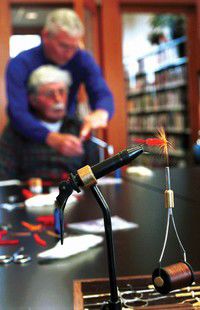Why fly? – An abbreviated history of fly fishing and tying
Published 5:00 pm Tuesday, September 24, 2002

- Tim Liddiard of Naselle brushed up on his fly-tying skills with local master Chuck Cameron at a recent
“FLY TYING-The technique of fastening various materials on a hook to suggest real or fancied flies, or other insects or food objects for the purpose of deceiving fish.”
-The Wise Fishermen’s Encyclopedia, 1951
Exactly when man first discovered that feather-covered hooks could be very effective fishing equipment is shrouded in the mists of time.
We do know that the use of a flexible rod and bait meant to imitate insects can be traced back over two centuries throughout Europe.
The first clear description of fly fishing appeared in the book, “De Animalium Natura,” nearly 2,000 years ago. Author Claudius Aelianus reported that, “Fishermen wind red wool around their hooks and fasten to the wool two feathers that grow under a cock’s wattles.”
Throughout the centuries of time since, fly fishing and fly tying has seen a metamorphosis, not unsimilar to the stages of insect growth that many of the tying patterns imitate.
To start with, the line a fly is tied to has changed dramatically. In the 15th century, lines were made of twisted or braided horsehair. Avid fly fishers made lines that tapered from 12 or 15 hairs down to a casting line of one, two, or at most three hairs thick.
For the next 200 years or so, the required thickness of the horsehair line was hotly debated.
“A man who could not kill a trout twenty inches long with a double hair deserves not the name of angler,” from “Treatise of Fishing with an Angle” written by Dame Juliana Berners in 1651.
Horsehair was replaced by the 1800s when braiding machines were refined and cotton and flax lines were made. Leaders for these lines were generally made from silkworm gut. Drawn from the bowels of a silkworm, gut made fine, extremely strong leaders that were four to nine feet long, readily available by the 1800s.
Synthetic materials revolutionized the fly line after World War II. A polyvinyl chloride (PVC) coating was applied to a core of braided nylon, dacron or even fiberglass. This created the style of fly line still used today.
The rods used for fly fishing have also seen changes. Most notably, that of the materials used for creating them.
In 1653, Izaak Walton wrote “The Compleat Angler.” Walton wrote at a time when trout were fished with a single or double handed rod up to 20 feet long and made of six to eight pieces spliced together. The rods tapered like a switch and played with a true bend down to the hand. The incredibly long rod was required until reels allowed anglers to use more modest lengths.
Around the turn of the 19th century, British rod makers noted the outer layer of bamboo had a very high fiber density, and by splitting the canes and taking long thin strips of the outer layer, six or eight strips could be glued together to make a rod that outperformed the heavier wooden rods for anything less than a salmon. Split-cane rods, as they are known, have been the standard for purists of fly fishing to this day.
Fiberglass rods first became available in the 1940s, with graphite rods being introduced in 1973. Fiberglass and graphite are the most common materials used today for consumer-based fly rods.
Finally, we have the heart of fly fishing, the tied fly itself.
In the beginning of the 13th century, a German romance written by Wolfram von Eschenbach, mentions the catching of trout and grayling using a “feathered hook.” The hero of the novel wades barefoot in a stream to catch trout and grayling with a fly. From 1360 onwards, across a vast area reaching from the Swiss plain to Syria, other texts identify fly fishing as the chosen method of commoners.
Flies are often designed to mimic specific insects, but some useful flies bear no recognized resemblance to any living creature. The Victorian era was renowned for their exuberantly hued flies.
It was in 1747 that the initial book on fly-tying first appeared. “The Art of Angling” by Richard Bowlker, is widely regarded as the first handbook on the subject.
Bowlkner not only presented a list of his own flies, indicating some knowledge of entomology, but gave direct instructions on tying them. Around 1860, dry-fly fishing, in which the fly floats on the water’s surface, began to be popular in southern England. Prior to this development, a heavier weighted fly would float below the surface, known as wet-flies or streamers.
In a space of 50 years, the salmon fly had been transformed from a workmanlike object into a jewel. By the 1890s, a vast selection of patterns was available, and the well-equipped salmon fisherman’s fly-box was a riot of color.
Today, the American hair-wing type (where animal hair is used to represent the wings of the insect) is more common than traditional feather wing flies on salmon rivers all over the world. American influence in fly material has even pushed out deeply rooted English traditions. The hair-wing had become a significant influence on British patterns by the 1960s, with many traditional patterns being adapted to allow hair-wing ties.
Modern equipment has enhanced fly fishing, but the essence of the adventure is the same today as it was in Victorian times: a rod, a line and an artfully tied fly, cast to try and decieve an elusive fish.








